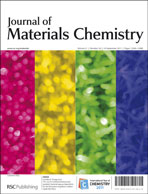Preparation of alkaline anion exchange polymer membrane from methylated melamine grafted poly(vinylbenzyl chloride) and its fuel cell performance
Abstract
A new material based on aminated and cross-linked methylated melamine grafted poly(vinylbenzyl chloride) was synthesized and used as a membrane for an alkaline anion exchange membrane


 Please wait while we load your content...
Please wait while we load your content...